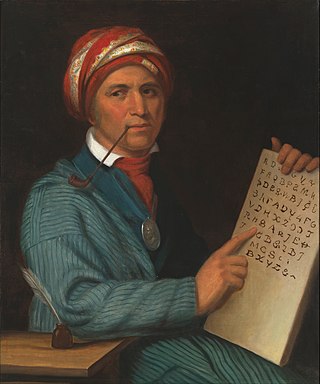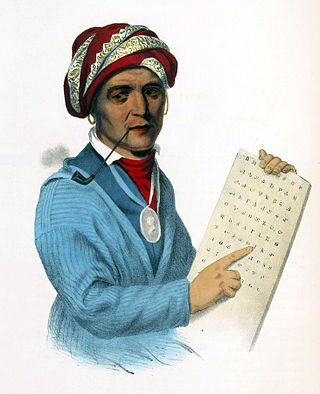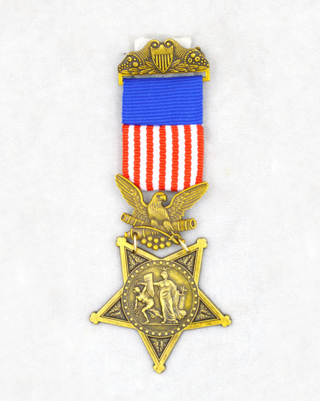Related Research Articles

The Cherokee people are one of the Indigenous peoples of the Southeastern Woodlands of the United States. Prior to the 18th century, they were concentrated in their homelands, in towns along river valleys of what is now southwestern North Carolina, southeastern Tennessee, southwestern Virginia, edges of western South Carolina, northern Georgia and northeastern Alabama consisting of around 40,000 square miles.
The following is a tabulation of United States military casualties of war.

Sequoyah, also known as George Gist or George Guess, was a Native American polymath and neographer of the Cherokee Nation. In 1821, he completed his independent creation of the Cherokee syllabary, enabling reading and writing in Cherokee. His achievement was one of the few times in recorded history that an individual member of a pre-literate group created an original, effective writing system. His creation of the syllabary turned the Cherokee nation into one of the first North American Indigenous groups with a written language. Sequoyah was also an important representative for the Cherokee nation; he went to Washington, D.C., to sign two relocation-and-land-trading treaties.

The Anglo-Cherokee War, was also known from the Anglo-European perspective as the Cherokee War, the Cherokee Uprising, or the Cherokee Rebellion. The war was a conflict between British forces in North America and Cherokee bands during the French and Indian War.

George H. Eldridge was an American soldier in the U.S. Army who served with the 24th Michigan Volunteer Infantry in the American Civil War and the 6th U.S. Cavalry during the Texas–Indian Wars. He received the Medal of Honor for gallantry fighting the Kiowa Indians and Chief Kicking Bird at the Battle of the Little Wichita River on July 12, 1870.

Elsatsoosu, also called Elsatsoosh, was an Apache Indian scout in the U.S. Army who served under Lieutenant Colonel George Crook during the Apache Wars. He guided cavalry troopers against renegade Apaches in the Arizona Territory during Crook's winter campaign of 1872–73 and was one of ten scouts later who received the Medal of Honor for gallantry.
Edwin L. Elwood was an American soldier in the U.S. Army who served with the 8th U.S. Cavalry during the Indian Wars. He took part in campaigns against Cochise and the Apache Indians in the Arizona Territory in the late-1860s and was one of thirty-two men received the Medal of Honor for gallantry during the fighting in the Chiricahua Mountains, known as the "Campaign of the Rocky Mesa", on October 20, 1869.
Nannasaddie was an Apache Indian scout in the U.S. Army who served under Lieutenant Colonel George Crook during the Apache Wars. He guided cavalry troopers against renegade Apaches in the Arizona Territory during Crook's winter campaign of 1872–73 and was one of ten scouts who later received the Medal of Honor for gallantry.
Francis Oliver was an American soldier in the U.S. Army who served with the 1st U.S. Cavalry during the Indian Wars. He was one of thirty-two men received the Medal of Honor for gallantry against the Apache Indians in the Chiricahua Mountains, later known as the "Campaign of the Rocky Mesa", on October 20, 1869.
John Francis O'Sullivan was an Irish-born soldier who emigrated to New York City, where he joined the United States Army who served with the 4th U.S. Cavalry during the Texas–Indian Wars. He received the Medal of Honor for gallantry against a hostile band of Indians at the Staked Plains in Texas on December 8, 1874.
William O'Neill was an American soldier in the U.S. Army who served with the 4th U.S. Cavalry during the Indian Wars. He was one of several men who received the Medal of Honor for gallantry while fighting the Comanche at Red River of the South on September 29, 1872.
John James was a British-born American soldier in the U.S. Army who served with the 5th U.S. Cavalry during the Indian Wars. He was one of seven men who received the Medal of Honor for gallantry during the Battle of the Upper Washita River near Canadian, Texas on September 9–11, 1874.
Edward Johnston was an American soldier in the U.S. Army who served with the 5th U.S. Cavalry during the Indian Wars. He was one of thirty-one men received the Medal of Honor for gallantry during General Nelson A. Miles winter campaign against the Sioux in the Montana Territory from October 21, 1876, to January 8, 1877.
Hermann Emil Fichter was an American soldier in the U.S. Army who served with the 3rd U.S. Cavalry during the Apache Wars. He was one of five men received the Medal of Honor for gallantry battling the Apache Indians in the Whetstone Mountains of Arizona on May 5, 1871.
Private Christopher Freemeyer was a German-born soldier in the U.S. Army who served with the 5th U.S. Infantry during the Indian Wars. He was one of thirty-one men who received the Medal of Honor for gallantry during General Nelson A. Miles campaign against the Sioux in the Montana Territory from October 1876 to January 1877.
Sergeant William Foster was a British-born soldier in the U.S. Army who served with the 4th U.S. Cavalry during the Texas–Indian Wars. He received the Medal of Honor for gallantry against the Comanche Indians at the Red River in Texas on September 29, 1872.
Private John Tracy, born Henry G. Nabers, was an Irish-born soldier in the U.S. Army who served with the 8th U.S. Cavalry during the Apache Wars. He was one of thirty-two men received the Medal of Honor for gallantry in fighting Cochise and the Apache Indians in the Chiricahua Mountains of Arizona, later known as the "Campaign of the Rocky Mesa", on October 20, 1869.

First Sergeant Richard Barrett was an Irish-born American soldier in the U.S. Army who served with the 1st U.S. Cavalry Regiment during the Indian Wars. He was awarded the Medal of Honor during the Apache Wars when he voluntarily led a charge against a group of hostile Tonto Apaches at Sycamore Canyon on May 23, 1872.

The historic Cherokee settlements were Cherokee settlements established in Southeastern North America up to the removals of the early 19th century. Several settlements had existed prior to and were initially contacted by explorers and colonists of the colonial powers as they made inroads into frontier areas. Others were established later.
References
- 1 2 "San Diego Cherokee Nation citizen also TV personality". Cherokeephoenix.org. 2009-11-06. Archived from the original on 2012-06-07. Retrieved 2014-05-10.
- ↑ Konstantin, Phil (2002). This Day in North American Indian History. Da Capo Press. pp. 1–2. ISBN 0306811707.
- ↑ Konstantin, Phil (2002). This Day in North American Indian History. Da Capo Press. pp. 367–456. ISBN 0306811707.
- 1 2 Moreland, Jo (November 11, 2002). "CHP officer writes American Indian history book". The Californian. p. 5.
- ↑ "This Day in North American Indian History". Publishers Weekly. October 1, 2002.
- ↑ Ankeny, Chrys (December 2003). "This Day in North American Indian History". Wild West. 16 (4): 57. ProQuest 201441264.
- ↑ "This Day in North American Indian History". Booklist. 99 (17): 1614. May 1, 2003. ProQuest 235548229.
- ↑ Farris, Dale (October 1, 2002). "This Day in North American Indian History". Library Journal. 127 (16): 82. ProQuest 196812191.